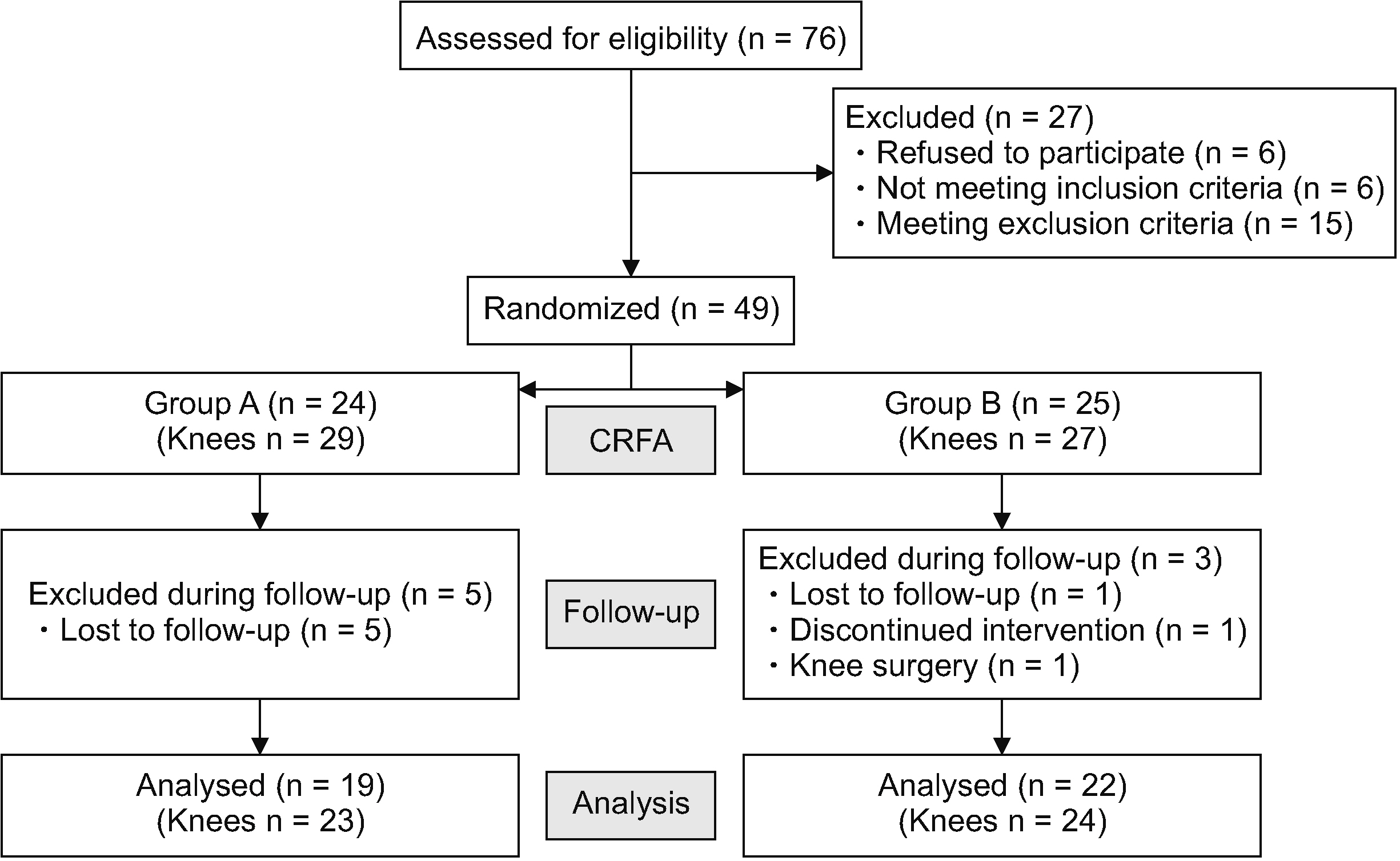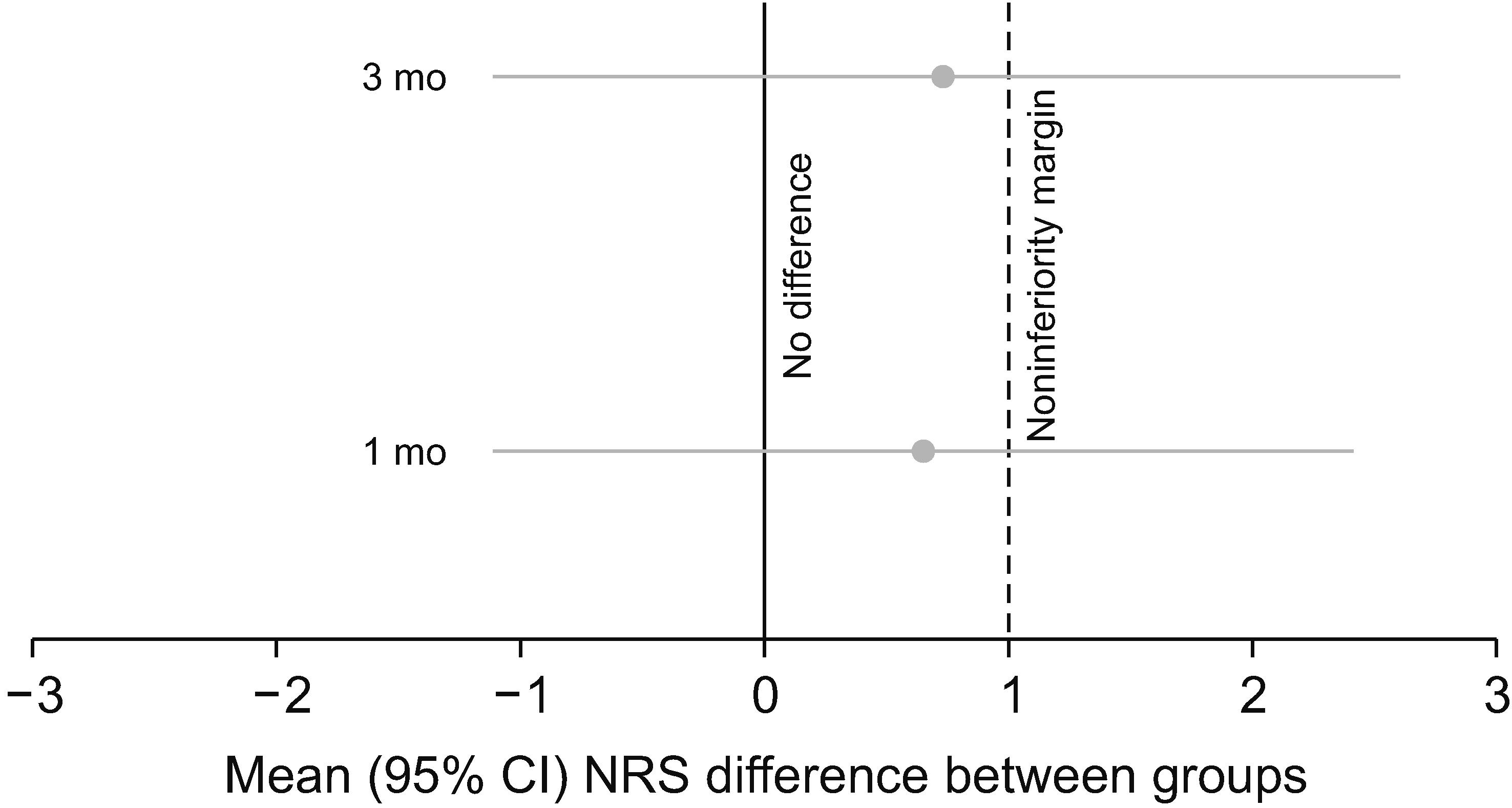Korean J Pain.
2024 Jul;37(3):264-274. 10.3344/kjp.24098.
Is conventional radiofrequency ablation of the superolateral branch, one of the three genicular nerves targeted as standard, necessary or not? A non-inferiority randomized controlled trial
- Affiliations
-
- 1Department of Physical Medicine and Rehabilitation, Sultanbeyli State Hospital, Istanbul, Turkiye
- 2Department of Physical Medicine and Rehabilitation, Marmara University Faculty of Medicine, Istanbul, Turkiye
- 3Division of Pain Medicine, Department of Physical Medicine and Rehabilitation, Marmara University Faculty of Medicine, Istanbul, Turkiye
- KMID: 2557730
- DOI: http://doi.org/10.3344/kjp.24098
Abstract
- Background
Radiofrequency ablation is an effective treatment modality in the symptomatic treatment of knee osteoarthritis. Our aim was to compare the efficacy of radiofrequency ablation of the superomedial and inferomedial genicular nerves (2 branches) with the superolateral, superomedial, and inferomedial genicular nerves (3 branches) and to show whether the 2-branch procedure is inferior to the 3-branch procedure.
Methods
This study is a prospective, randomized, single-blind clinical study. Eligible participants were randomized into 2 groups: group A, which applied the procedure to the superomedial and inferomedial genicular nerves, and group B, which applied it to the superomedial, superolateral and inferomedial genicular nerves. Pain was evaluated with the numerical rating scale, quality of life with the Short Form-36 (SF-36), and disability with the Western Ontario and McMaster Universities (WOMAC) Osteoarthritis Index before, and at 1 and 3 months after the procedure.
Results
A total of 41 patients were included. There were no differences between the groups except for the SF-36 physical health sub-score at baseline. A significant improvement was seen in the numeric rating scale (NRS) score, SF-36 sub-scores, WOMAC Index total, as well as pain and physical function scores in both groups, though no significant difference was detected between the groups during follow-up.
Conclusions
Although we were unable to establish the noninferiority of conventional radiofrequency ablation (CRFA) applied to 2 branches to CRFA applied to 3 branches, in this trial, significant and similar improvement was observed in NRS, WOMAC total, pain, and physical function and SF-36 scores in both groups.
Keyword
Figure
Reference
-
1. Glyn-Jones S, Palmer AJ, Agricola R, Price AJ, Vincent TL, Weinans H, et al. 2015; Osteoarthritis. Lancet. 386:376–87. DOI: 10.1016/S0140-6736(14)60802-3. PMID: 25748615.2. Choi WJ, Hwang SJ, Song JG, Leem JG, Kang YU, Park PH, et al. 2011; Radiofrequency treatment relieves chronic knee osteoarthritis pain: a double-blind randomized controlled trial. Pain. 152:481–7. DOI: 10.1016/j.pain.2010.09.029. PMID: 21055873.
Article3. El-Hakeim EH, Elawamy A, Kamel EZ, Goma SH, Gamal RM, Ghandour AM, et al. 2018; Fluoroscopic guided radiofrequency of genicular nerves for pain alleviation in chronic knee osteoarthritis: a single-blind randomized controlled trial. Pain Physician. 21:169–77. DOI: 10.36076/ppj.2018.2.169.4. Qudsi-Sinclair S, Borrás-Rubio E, Abellan-Guillén JF, Padilla Del Rey ML, Ruiz-Merino G. 2017; A comparison of genicular nerve treatment using either radiofrequency or analgesic block with corticosteroid for pain after a total knee arthroplasty: a double-blind, randomized clinical study. Pain Pract. 17:578–88. DOI: 10.1111/papr.12481. PMID: 27641918.
Article5. Jadon A, Jain P, Motaka M, Swarupa CP, Amir M. 2018; Comparative evaluation of monopolar and bipolar radiofrequency ablation of genicular nerves in chronic knee pain due to osteoarthritis. Indian J Anaesth. 62:876–80. DOI: 10.4103/ija.IJA_528_18. PMID: 30532324. PMCID: PMC6236782.
Article6. Yildiz G, Perdecioglu GRG, Yuruk D, Can E, Akkaya OT. 2023; Comparison of the efficacy of genicular nerve phenol neurolysis and radiofrequency ablation for pain management in patients with knee osteoarthritis. Korean J Pain. 36:450–7. DOI: 10.3344/kjp.23200. PMID: 37732409. PMCID: PMC10551393.
Article7. Creamer P, Lethbridge-Cejku M, Hochberg MC. 1998; Where does it hurt? Pain localization in osteoarthritis of the knee. Osteoarthritis Cartilage. 6:318–23. DOI: 10.1053/joca.1998.0130. PMID: 10197166.
Article8. Kesikburun S, Yaşar E, Uran A, Adigüzel E, Yilmaz B. 2016; Ultrasound-guided genicular nerve pulsed radiofrequency treatment for painful knee osteoarthritis: a preliminary report. Pain Physician. 19:E751–9. DOI: 10.36076/ppj/2019.19.E751.9. Ajrawat P, Radomski L, Bhatia A, Peng P, Nath N, Gandhi R. 2020; Radiofrequency procedures for the treatment of symptomatic knee osteoarthritis: a systematic review. Pain Med. 21:333–48. DOI: 10.1093/pm/pnz241. PMID: 31578561.
Article10. Conger A, McCormick ZL, Henrie AM. 2019; Pes anserine tendon injury resulting from cooled radiofrequency ablation of the inferior medial genicular nerve. PM R. 11:1244–7. DOI: 10.1002/pmrj.12155. PMID: 30859692.
Article11. Khan D, Nagpal G, Conger A, McCormick ZL, Walega DR. 2020; Clinically significant hematoma as a complication of cooled radiofrequency ablation of the genicular nerves; a case series. Pain Med. 21:1513–5. DOI: 10.1093/pm/pnz319. PMID: 31880783.12. McCormick ZL, Walega DR. 2018; Third-degree skin burn from conventional radiofrequency ablation of the inferiomedial genicular nerve. Pain Med. 19:1095–7. DOI: 10.1093/pm/pnx204. PMID: 29025030.
Article13. Khanna A, Knox N, Sekhri N. 2019; Septic arthritis following radiofrequency ablation of the genicular nerves. Pain Med. 20:1454–6. DOI: 10.1093/pm/pny308. PMID: 30698785.
Article14. Deyle GD, Allen CS, Allison SC, Gill NW, Hando BR, Petersen EJ, et al. 2020; Physical therapy versus glucocorticoid injection for osteoarthritis of the knee. N Engl J Med. 382:1420–9. DOI: 10.1056/NEJMoa1905877. PMID: 32268027.15. McCormick ZL, Korn M, Reddy R, Marcolina A, Dayanim D, Mattie R, et al. 2017; Cooled radiofrequency ablation of the genicular nerves for chronic pain due to knee osteoarthritis: six-month outcomes. Pain Med. 18:1631–41. DOI: 10.1093/pm/pnx069. PMID: 28431129.
Article16. Salaffi F, Stancati A, Silvestri CA, Ciapetti A, Grassi W. 2004; Minimal clinically important changes in chronic musculoskeletal pain intensity measured on a numerical rating scale. Eur J Pain. 8:283–91. DOI: 10.1016/j.ejpain.2003.09.004. PMID: 15207508.
Article17. Farrar JT, Young JP Jr, LaMoreaux L, Werth JL, Poole MR. 2001; Clinical importance of changes in chronic pain intensity measured on an 11-point numerical pain rating scale. Pain. 94:149–58. DOI: 10.1016/S0304-3959(01)00349-9. PMID: 11690728.
Article18. Angst F, Aeschlimann A, Stucki G. 2001; Smallest detectable and minimal clinically important differences of rehabilitation intervention with their implications for required sample sizes using WOMAC and SF-36 quality of life measurement instruments in patients with osteoarthritis of the lower extremities. Arthritis Rheum. 45:384–91. DOI: 10.1002/1529-0131(200108)45:4<384::AID-ART352>3.0.CO;2-0. PMID: 11501727.
Article19. Lin CJ, Saver JL. 2020; The minimal clinically important difference for achievement of substantial reperfusion with endovascular thrombectomy devices in acute ischemic stroke treatment. Front Neurol. 11:524220. DOI: 10.3389/fneur.2020.524220. PMID: 33123069. PMCID: PMC7569750.
Article20. Davis T, Loudermilk E, DePalma M, Hunter C, Lindley D, Patel N, et al. 2018; Prospective, multicenter, randomized, crossover clinical trial comparing the safety and effectiveness of cooled radiofrequency ablation with corticosteroid injection in the management of knee pain from osteoarthritis. Reg Anesth Pain Med. 43:84–91. DOI: 10.1097/AAP.0000000000000690. PMID: 29095245. PMCID: PMC5768219.21. Uematsu H, Osako S, Hakata S, Kabata D, Shintani A, Kawazoe D, et al. 2021; A double-blind, placebo-controlled study of ultrasound-guided pulsed radiofrequency treatment of the saphenous nerve for refractory osteoarthritis-associated knee pain. Pain Physician. 24:E761–9. DOI: 10.36076/ppj.2021.24.E761.
Article22. Santana-Pineda MM, Vanlinthout LE, Santana-Ramírez S, Vanneste T, Van Zundert J, Novalbos-Ruiz JP. 2021; A randomized controlled trial to compare analgesia and functional improvement after continuous neuroablative and pulsed neuromodulative radiofrequency treatment of the genicular nerves in patients with knee osteoarthritis up to one year after the intervention. Pain Med. 22:637–52. DOI: 10.1093/pm/pnaa309. PMID: 33179073.
Article23. Ikeuchi M, Ushida T, Izumi M, Tani T. 2011; Percutaneous radiofrequency treatment for refractory anteromedial pain of osteoarthritic knees. Pain Med. 12:546–51. DOI: 10.1111/j.1526-4637.2011.01086.x. PMID: 21463469.24. Tran J, Peng PWH, Lam K, Baig E, Agur AMR, Gofeld M. 2018; Anatomical study of the innervation of anterior knee joint capsule: implication for image-guided intervention. Reg Anesth Pain Med. 43:407–14. DOI: 10.1097/AAP.0000000000000778. PMID: 29557887.25. Conger A, Cushman DM, Walker K, Petersen R, Walega DR, Kendall R, et al. 2019; A novel technical protocol for improved capture of the genicular nerves by radiofrequency ablation. Pain Med. 20:2208–12. DOI: 10.1093/pm/pnz124. PMID: 31131850.
Article26. McCormick ZL, Cohen SP, Walega DR, Kohan L. 2021; Technical considerations for genicular nerve radiofrequency ablation: optimizing outcomes. Reg Anesth Pain Med. 46:518–23. DOI: 10.1136/rapm-2020-102117. PMID: 33483425.
- Full Text Links
- Actions
-
Cited
- CITED
-
- Close
- Share
- Similar articles
-
- Comparison of the efficacy of genicular nerve phenol neurolysis and radiofrequency ablation for pain management in patients with knee osteoarthritis
- Chemoembolization Combined with Radiofrequency Ablation for Patients with Hepatocellular Carcinoma Larger Than 3 cm: A Randomized Controlled Trial
- Predictive factors associated with successful response to utrasound guided genicular radiofrequency ablation
- Cooled radiofrequency ablation of genicular nerves for knee osteoarthritis
- Radiofrequency Catheter Ablation of Ventricular Tachycardia in Patients without Structural Heart Disease



